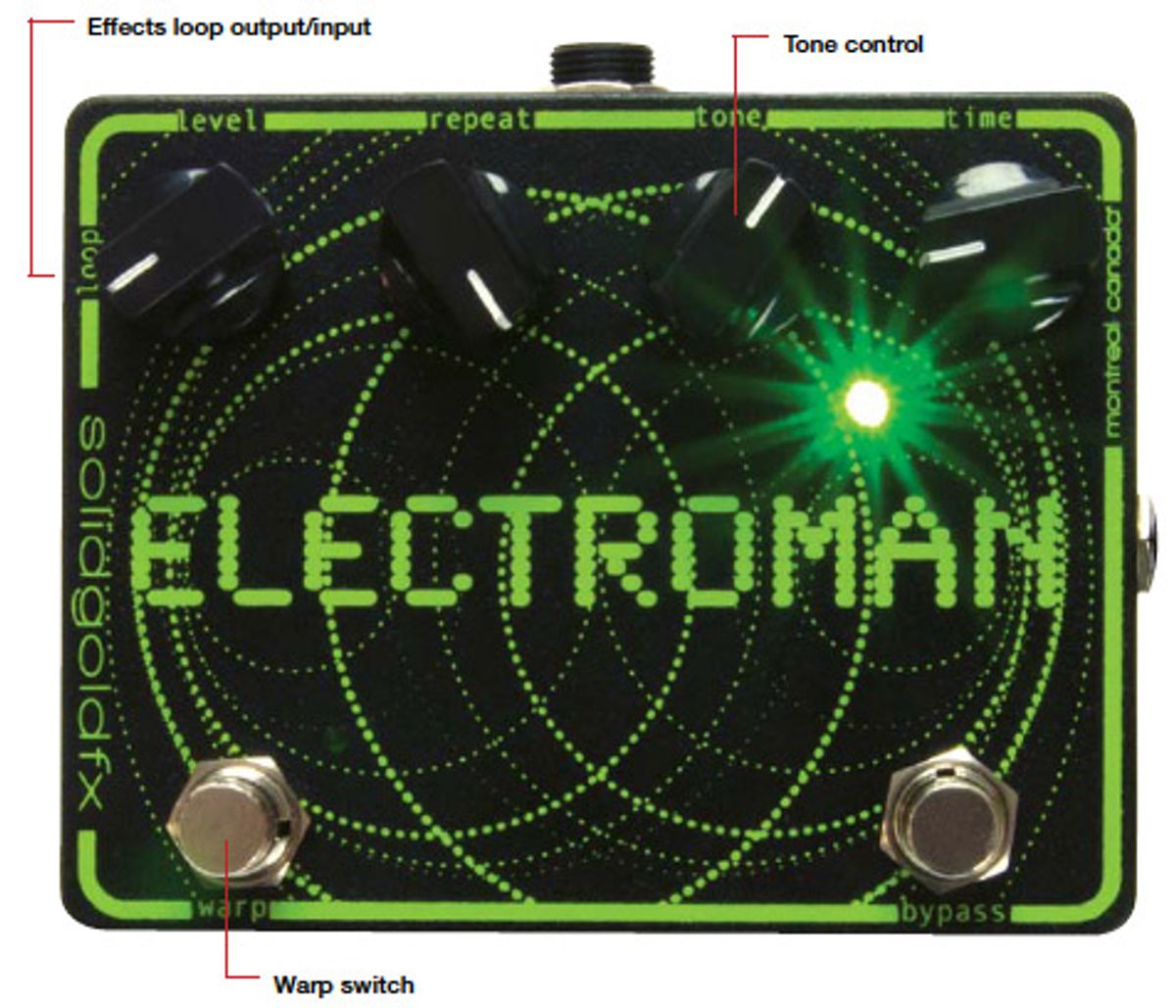
The Electroman digital-delay demonstrates an appreciation for both extremes of the Echoplex’s performance envelope, and the know-how to make both straightforward and unusual delay sounds that are practical and inspiring.
| Download Example 1 Fender Strat, Bridge Pickup, Level 3 o'clock, Repeat 3 o'clock, Tone 9 o'clock, Time 1 o'clock. Warp switch engaged on every 4th chord. Warp switch held on last chord to illustrate how the self-oscillation can drive an amplifier. | |
| Download Example 2 Same settings as above but Time knob is twisted after self-oscillation begins to illustate pitch bending effect. | |
| Download Example 3 Gibson SG, Bridge Pickup, Level noon, Repeat 2 o'clock, Tone 9 o'clock, Time 1 o'clock. | |
| All clips were input into an Electro-Harmonix 44-Magnum power amp feeding an Emperor solid birch 4x12" with Weber C1265s recorded using a Shure SM57. | |
Built For Space Travel
Solid Gold FX makes little effort to conceal the Electroman’s potential for out-there sonics. The neon, alien-green-on-black, LED-inspired graphics give you the sense this might be an instrument left behind in an alien abduction (or at least a movie about one). But the true-bypass Electroman doesn’t require a degree in astrophysics—it’s easy to operate and navigate.
There are knobs for Level, which sets the level of the delayed signal, and Repeat (otherwise known as feedback), which dials in the level of an echo relative to its previous echo. The Tone knob determines the level of filtering applied to each delay repeat, and the Time control sets the amount of time between echoes, which ranges from short slapback echoes up to 600 ms of delay.
Two footswitches, Bypass and the enticing Warp switch (which induces a self-oscillation effect), round out the Electroman’s controls. In addition to 1/4" input and output jacks, a 1/4" effects loop jack lets you add additional textures to the delay via outboard effects and a TRS Y cable.
Tone Trials
With a Fender Stratocaster in hand, I began my first investigations of the Electroman’s capabilities with tweaks of the Tone control. Rolling off the Tone control darkens successive repeats by filtering away high frequencies. As with a vintage tape unit, this makes each echo progressively less apparent. But much to the delight of my analog-synth-fixated ear, it also imparts some qualities of low-pass filtering that give the Electroman an individual sonic signature.
Bringing the Tone control up brightens the delays, but interestingly, I never landed on a setting that sounded like unfiltered, mirror-image echoing. There almost always seemed to be some sort of tone coloration, which gives the Electroman’s delayed signal a singing resonance and pleasing harmonic richness that lends a cool vintage touch and helps the Electroman carve out sonic territory without getting too muddy.
Toying with the Repeat knob reveals more about the wilder side of the Electroman. With the Repeat set to three o’clock, you’ll get an infinitely recurring signal and anything higher will eventually self-oscillate. You can keep this effect mellow and understated, of course. By setting the Repeat control low and cranking the Tone control, I was able to achieve a really convincing 1950s-style slapback echo that would be great for country and rockabilly.
But inverting the settings of those two controls gave me a dark and lingering shoegazey delay that faded very slowly. And using those settings with the Warp switch transformed the sound more radically still. Instead of delicately undulating towards silence, the echoes gradually become louder and louder, eventually shrieking and pounding as if you were concurrently cranking the repeat and level controls on an analog or tape delay. And the real beauty of the Warp switch is that releasing it will taper the oscillation before it can overwhelm or destroy a song or your audience’s eardrums. This produces a natural crashing wave of sound that is great for transitions between songs in a performance or punctuating a solo section.
Sending the Electroman into self-oscillation does not mean you’ve reached the limit of the pedal’s possibilities. With the Warp switch depressed, you can still tweak the Time control to pitch-bend the oscillations, creating a cool Doppler effect. And with the effects loop, you can color the delayed signal in ways that lend more dimension than simply placing an overdrive or distortion in front of a delay.
The Verdict
In terms of features and sounds, the Electroman is most inspired by vintage tape delays. As such, it lacks some features that modern players are accustomed to, such as tap tempo, stereo output, ultra-long delays, and expression-pedal control. On the other hand, the Electroman is delightfully simple to operate and delivers sweet tone. And practical features like its effects loop can extend the pedal’s capabilities in unique ways. Add the amazingly cool Warp and self-oscillating feature into the mix, and you have a delay that may guide you into some very unexpected realms.
At $225, it’s a little pricier than your average off-the-shelf, mass-manufactured delay unit. But the Electroman is not as expensive as many boutique pedals that don’t have its sound-warping potential. And if you’re into custom graphics, there’s even a one-of-a-kind airbrushing option for personalizing your pedal. But even if you’re just looking for a great sounding, handmade, high-quality stompbox that can also take you on some less-than-conventional sonic sojourns, the Electroman is an echo machine well worth investigating.
Buy if...
you want a less-generic sounding digital delay with the capability to deliver unusual oscillation effects.
Skip if...
you need more than 800 ms of delay, stereo output, expression pedal control, or tap tempo.
Rating...
Street $225 - Solid Gold FX - solidgoldfx.com |
From Your Site Articles

